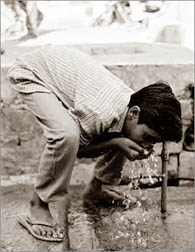World Water Day
Beyond a drop of water
Dealing with water scarcity :
by Indeewara Thilakarathne
 Although most of us take water for granted, it has increasingly
become a scarce resource denying section of the humanity access to water
for food and livelihood. In principle, water scarcity the world
confronts today, has been categorized into three types; physical water
scarcity, economic scarcity and institutional scarcity. Although most of us take water for granted, it has increasingly
become a scarce resource denying section of the humanity access to water
for food and livelihood. In principle, water scarcity the world
confronts today, has been categorized into three types; physical water
scarcity, economic scarcity and institutional scarcity.
The physical water scarcity occurs when available water resources are
insufficient to meet the growing demand for water, for production of
food and sustenance of livelihood.
The economic water scarcity arises out of inadequate investment or
lack of human capacity to withdraw water from available sources.
Finally, the institutional scarcity occurs when section of the
population is denied access to water resources on the ground of
political and social reasons.
It is imperative that a fundamental shift of paradigms in water
management should be brought about in order to deal with these three
types of scarcity. At present, 1.2 billion people live in areas of
physical water scarcity while around 1.6 billion people world wide live
in water scarce basins where there is economic scarcity. It is also
estimated that only 31 percent of Sri Lankans have access to pipe-bone
water.
The Comprehensive Assessment of Water Management in Agriculture (CA),
a study spearheaded by the Colombo based International Water Management
Institute (IWMI), has converged a think tank of 700 scientists around
the globe.
It has been estimated that seventy percent of poor in the world,
approximately 800 million live in rural Africa and Asia have poor access
to reliable, affordable water for food and livelihood.
|

The Victoria Dam
|
A research titled ?Beyond More Crop per Drop? which was co-authored
by Prof. Frank Rijsberman, Director General IWMI and Nadia Mannings, a
research fellow at IWMI, has pointed out that approximately seventy
times of water is used for growing food than human consumption for
domestic use. As much as 2000 litres of water are required to produce a
kilo of rice and 11,000 litre for a single quarter pounder hamburger.
The research further stated that many rivers in arid and semi-arid
regions are no longer reaching the sea either closing the river basins
or in the process of being closed.
According to AC, the demand for food would be double by 2050 with the
increasing trends in food consumption. This would, invariably, increase
the demand for water in agriculture triggering a widespread water
scarcity. Therefore, it is imperative to explore ways and means to
improve crop per drop.
The rapidly growing need for water in agriculture would compel more
and more withdrawals of water, modifications of flow regimes and
degradation of water quality with major implications to ecosystem
health.
Make a critical assessment and evaluation of the benefits, costs and
the impacts of the past 50 years of development. CA, a five year
programme has comprehensively covered the areas of current water
management challenges and the solutions developed around the world.
The findings of the research which specially focus on agricultural
producers, water managers, investors, policy makers and civil society,
has facilitated better investments, management decisions in water and
agriculture considering their impact over the next 50 years.
In the final report of the CA, an agenda for future water management
was outlined with recommendations to improve water management.
Improvement of water productivity
However, the challenges the world faces in water management are the
finding water for growing cities, growing food for rising population and
providing jobs for rural poor while the sustaining environment.
The recommendations for increasing water productivity include
enhancing the safe and productive use of wastewater, multiple use
systems; single water system for domestic use, agriculture, aquaculture
and livestock and also to improve water productivity through
supplementary and micro-irrigation.
In the face of looming crisis, pragmatic policy decisions have to be
taken by individual governments and world bodies such as UN to tackle
this issue. Some kind of water rights or entitlement should be
introduced to make sure that available water resources management is in
a sustainable and productive manner.
[email protected]
****
Recommendations of the Comprehensive Assessment of Water Management
in Agriculture (CA)
Think different about water; there is no more ?new? water for one
fifth (1.2 million) of the world population in developing lands in Asia
and North Africa. Their only option is to reallocate water to higher
value uses. For the other 1.6 billion people, face water scarcity,
constructing more water storage is a key priority.
Get water to People; Providing water for smallholding farmers in
marginal or vulnerable areas through small scale technologies ranging
from treadle pumps to micro-drip kits, combined with micro credit and
access to markets is a proven strategy to fight poverty.
Increase water Productivity; Improvement in water productivity at
farm level through smart field practices , such as conservation tilling,
land levelling to improve irrigation scheduling and breeding through
resistant crop varieties can make a bid different .
Look at other options for agricultural water management; There is
great potential for improving crop yields by providing supplementary
irrigation to rainfed systems through rainwater harvesting in farm ponds
or community managed dams. (The CA report also urged the ? safe? use of
marginal quality water such as brackish water and treated or partially
treated wastewater which can be critical resources for improving
livelihoods) In countries such as India, Pakistan and Africa, farmers
use wastewater to grow cash crops.
Manage Agriculture for multiple ecosystem services; Planning water
use in integrated systems for domestic use, crop growth, aquaculture,
livestock and ecosystems such as wetland, offers scores for doubling or
trebling water value. For example, multi-functional paddy fields can
grow rice, rear fish and ducks, thereby generating livelihood for
small-scale farmers while supporting biodiversity.
Reform the State to improve the governance of water; Government needs
to enable water to be reallocated from lower to higher value users
including transfers from agriculture to cities and industry.
They can also provide incentives for water conservation including
rewards for saving water. Water quality standards should be set and
enforced and there should be a system of water (use) rights or
entitlements.
Deal with trade-offs and difficult choices; A lot of hard choices
have to be made often creating winners and losers. Usually the ?losers?
are poor farmers, livestock herders and fishermen. What is needed here
are informed negotiations where all stakeholders are brought to the
table. |
